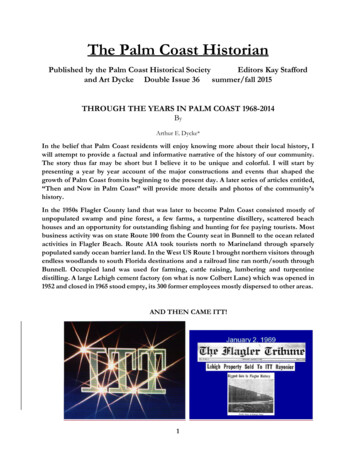
Transcription
10NUTRITIONALFACTS ABOUTPALM OIL
1Fits in ahealthy diet
Healthy diet and lifestyleHealthy eating involves focusing on the total dietand the overall food pattern. All foods can fit withina healthy diet when consumed in moderation. Simplyput, a healthy diet and lifestyle is based on threeelements: variation in foods and meals, a balancedenergy intake and enough physical activity to preventweight gain. A healthy diet includes lots of fruits andvegetables, a balanced carbohydrate, fat and proteinintake, and avoiding a high intake of salt, refinedcarbohydrates, saturated fats and trans fats.A switch to a more plant based diet will alsocontribute to a more sustainable and healthy planet.Role among the fats we consumePalm oil has a role to play among the fats weconsume because of its specific composition, andparticularly to meet technological requirements ofsome of the foods we consume. It has contributed tothe almost total disappearance of industrial trans fats,specifically in the Western European food market andis an excellent alternative to animal fats.
2Edible oil fromthe fruits ofthe palm oiltree
Edible oilPalm fruit oil, generally known as palm oil, is oneof the edible oils cited by the Codex AlimentariusCommission of the joint FAO/WHO Food StandardsProgramme.1Palm fruitsThe oil is pressed from the orange pulp of palm fruits.Palm fruits are about the size of small plums andgrow in bunches on the tropical palm oil tree. Eachbunch contains a thousand or more palm fruits thatare harvested throughout the year.Indonesia and MalaysiaOriginally found in West Africa, the oil palm tree isnow mostly cultivated in Indonesia and Malaysia, theworld’s largest palm oil-producing nations. In morerecent years oil palms are also cultivated in SouthAmerica and in particular in Colombia.
3Used in a widerange of foods
Refined palm oilIn Europe, palm oil is used in its refined (or refined,bleached, deodorised) form. Refined palm oil isodourless and pale yellow, making it a valuableingredient providing texture and taste in a widerange of foods, such as margarine, confectionery,chocolate, ice cream and bakery products.Palm oil fractionsFractionating refined palm oil involves separating theoil into fractions with different melting properties: aliquid (olein) and a solid (stearin) fraction. Palm oleinis sold as cooking oil or used in food manufacturingsuch as instant noodles and fried food products.Palm stearin is used to make the hard components(‘hard stock’) of margarines and shortenings*. Palmolein can be further fractionated to produce superolein, hard stearin and palm mid fraction. Superolein is a more liquid fraction and withstands a lowertemperature than palm olein before it solidifies.The palm-mid fraction is a key component of cocoabutter alternatives.* a type of (semi-) solid fat that is used in cooking and baking
4Concentratedsource ofenergy for thebody
Various functions of fatLike all fats and oils, palm oil is a concentrated sourceof energy for our body. One gram of fat provides9 kcal, while carbohydrates and proteins provide 4kcal per gram. Fat is the main storage form of excessenergy in the body. Fats also cushion organs duringmovement, insulate the body and help to maintaina normal body temperature. Fats are structuralcomponents of cell membranes and hormones.Some types of vitamins (A, D, E and K) rely on fat forabsorption and storage.Recommended fat intakeThe World Health Organization recommends that in ahealthy diet between 15 and 35% of the daily caloriesshould be obtained from fat.2 This percentage variesaccording to the health situation of people as well asto the sort of diet (especially which staple foods areconsumed). Of the total fat intake a maximum of 10%saturated fatty acids is recommended.
5Balancedcomposition ofsaturated andunsaturatedfatty acids
Unique and balanced fat compositionPalm oil contains an equal proportion of saturatedand unsaturated fatty acids. Of these fatty acids,approximately 40% is monounsaturated oleic acid,10% is polyunsaturated linoleic acid, 44% is saturatedpalmitic acid and 5% is saturated stearic acid.Compared to coconut oil, butter and cocao butterThe proportion of saturated fats in palm oil is lowerthan the saturated fat content of other fats of similarapplication: coconut oil (93% saturates), butter (70%saturates) and cocoa butter (64% saturates).
6Successfulalternative toreplacetrans fattyacids
XTFAPALMLess than 2% trans fatty acidsTrans fatty acids have been proven to havedetrimental effects on health. These compounds areformed when a liquid oil is made (more) solid.No partial hydrogenationHaving a unique and balanced composition ofsaturated and unsaturated fatty acids, palm oilgenerally does not require partial hydrogenation(‘hardening’) in applications where solid fat isdesirable, thus avoiding the formation of trans fattyacids. Palm oil has become a favourite ingredient forthese applications.Reducing trans fats in foodsUsing palm oil instead of partially hydrogenatedvegetable oils reduces the content of trans fats infoods made with these oils. No other vegetablefat with a semi-solid texture at room temperatureand providing the same features exists in sufficientquantity. The EU has issued legislation to set amaximum of 2% trans as a legal limit.3
7Rich inantioxidantvitamin E
ERich in vitamin ECrude or unrefined palm oil contains 60 to 100 mgvitamin E per 100 gram. An average of 50 to 65% ofthe vitamin E content remains after refining, which isstill higher than in other refined vegetable oils.Tocotrienols70% of the vitamin E in palm oil occurs astocotrienols. In contrast, other vegetable oils such ascorn, olive, soybean, and sunflower, are good sourcesof tocopherols but contain no tocotrienols.Unique biological propertiesCurrent research suggests unique biologicalproperties of tocotrienols and warrants furtherinvestigation.4,5
8Most widelyconsumedvegetable oil inthe world
Rising global consumptionGlobal production of palm oil rose from 14.6 milliontons in 1995 to over 70 million tons in 2020 with over2/3 destined to food. Palm oil is currently the mostconsumed vegetable oil in the world. The main palmoil consuming markets are China, India, Indonesia andthe European Union. The big advantage of palm oil is,that it uses less land than any other oil crop.Daily intake in France, Spain en GermanyPalm oil consumption levels were estimated byCREDOC in France in 2013. On average, the French( 3 years of age) consume 2.8 gram of palm oil perday, which corresponds to approximately 4% of theoverall saturated fat intake in adults.6In 2020 a study was done on the intake of palm oil inboth Spain and Germany.7 The mean intake in Spain isestimated to vary between 2.06 and 4.54 g/day andin Germany between 3.06 and 6,22 g/day.
9Rich in provitamin Acarotenoids(crude, unrefinedpalm oil)
ACarotenoid pigmentsCarotenoids are natural pigments responsible forthe red-orange colour of crude palm oil. 100 Gramof crude palm oil contains 50 to 70 mg carotenoids.These are mainly beta carotene (56%) and alphacarotene (35%) and are the same compounds thatgive the orange colour to carrots, pumpkin and sweetpotatoes.Pro vitamin ACarotenoids act as precursors of vitamin A, whichplays an important role in good vision, a healthyimmune system and cell growth. The pro vitamin A(retinol) equivalent content of crude palm oil hasbeen estimated at 15 times that of carrots.Red palm oilStandard oil refining removes all carotenoids, butabout 80% of these valuable components areretained in a product called ‘red palm oil’, resultingAfrom a modified refining procedure. Red palm oil isused for the treatment and prevention of vitamin Adeficiency in many countries worldwide.8
10Long history ofdietary use
Ancient tropical plantThe oil palm is an ancient tropical plant from theWest African tropical rainforest region. The use ofpalm oil in human nutrition dates back thousandsof years. In the late 1800s, archeologists discovereda substance that they concluded was palm oil in atomb at Abydos dating back to 3000 BCE.Traditional usePalm oil is traditionally used as a cooking ingredientin the tropical belt of West Africa, South East Asiaand Brazil.
References
- References 1.2.3.4.5.6.7.8.Codex Alimentarius. Codex Standard for NamedVegetable Oils CX-STAN 210-1999. CodexAlimentarius. Volume 8 - 2001.FAO/WHO. Fats and fatty acids in humannutrition. Report of an Expert Consultation. FAOFood and Nutrition Paper 2010; 91, ISBN978-92-5-106733-8.OJ L 110 from 25.04.2019, page 17, reg (EU)2019/649 from the European Commission.Imoisi OB. et al. Palm oil, its nutritional and healthimplications. JASEM. 2015;19(1):127-133.Meganathan P et al. Biological Properties ofTocotrienols: Evidence in Human Studies.International Journal of Molecular Sciences.2016;17:1682.Lecerf J-M et al. Know more about palm oil: frompalm grove to plate. Nutripratique. March 2016.Hearty et al, International Journal of FoodScience and Nutrition, 2020)Nagendran B et al. Characteristics of red palm oil,a carotene- and vitamin E-rich refined oil for fooduses. Food and Nutrition Bulletin. 2000;21(2):189194.
EPOA Rights reserved - 2021For more information, please contact us at:info@palmoilalliance.euwww.palmoilalliance.eu
Like all fats and oils, palm oil is a concentrated source of energy for our body. One gram of fat provides 9 kcal, while carbohydrates and proteins provide 4 kcal per gram. Fat is the main storage form of excess energy in the body. Fats also cushion organs during movement, insulate the body and help to maintain a normal body temperature. Fats .











